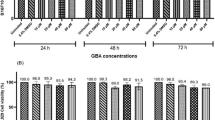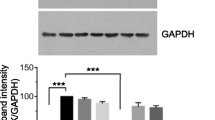Abstract
Purpose
On the basis of the inhibitory effect of quercetin on the invasion of melanoma B16-BL6 cells previously reported by us, the mechanisms of quercetin-mediated inhibition of invasion were further investigated in the present study.
Methods
The ability of B16-BL6 cells to invade and migrate was evaluated in terms of the numbers of cells penetrating a reconstituted basement membrane in the Transwell coculture system. The relative levels and activities of matrix metalloproteinase-9 (MMP-9) and MMP-2 were determined by gelatin zymography and quantified using LabWorks 4.0 software.
Results
The quercetin-mediated inhibition of invasion was partially blocked by phorbol-12,13-dibutyrate (PDB), a PKC (protein kinase C) activator, and by doxorubicin, a PKC inhibitor. Only the proforms of MMP-9 (92 kDa) and MMP-2 (72 kDa) were detected by gelatin zymography. Quercetin dose-dependently decreased the gelatinolytic activity of pro-MMP-9. Doxorubicin also markedly reversed the quercetin-induced decrease. Quercetin showed a dose-dependent antagonism of increases in gelatinolytic activity of pro-MMP-9 induced by PDB and free fatty acid (another PKC activator).
Conclusions
Together with the report that quercetin directly reduces PKC activity, the results reported here suggest that quercetin may inhibit the invasion of B16-BL6 cells by decreasing pro-MMP-9 via the PKC pathway.




Similar content being viewed by others
References
Crowe DL, Shuler CF (1999) Regulation of tumor cell invasion by extracellular matrix. Histol Histopathol 14:165
Saiki I (1997) Cell adhesion molecules and cancer metastasis. Jpn J Pharmacol 75:215
Kleiner DE, Stetler Stevenson WG (1999) Matrix metalloproteinase and metastasis. Cancer Chemother Pharmacol [Suppl] 43:S42
Westermarck J, Kahari VM (1999) Regulation of matrix metalloproteinase expression in tumor invasion. FASEB J 13:781
Xu J, Benyon RC, Leir SH, Zhang S, Holgate ST, Lackie PM (2002) Matrix metalloproteinase-2 from bronchial epithelial cells induces the proliferation of subepithelial fibroblasts. Clin Exp Allergy 32:881
Huang S, Van Arsdall M, Tedjarati S, McCarty M, Wu W, Langley R, Fidler IJ (2002) Contributions of stromal metalloproteinase-9 to angiogenesis and growth of human ovarian carcinoma in mice. J Natl Cancer Inst 94:1134
Okada N, Ishida H, Murata N, Hashimoto D, Seyama Y, Kubota S (2001) Matrix metalloproteinase-2 and 9 in bile as a marker of liver metastasis in colorectal cancer. Biochem Biophys Res Commun 288:212
Lengyel E, Schmalfeldt B, Konik E, Spathe K, Harting K, Fenn A, Berger U, Fridman R, Schmitt M, Prechtel D, Kuhn W (2001) Expression of latent matrix metalloproteinase 9 (MMP-9) predicts survival in advanced ovarian cancer. Gynecol Oncol 82:291
Rasmussen HS, McCann PP (1997) Matrix metalloproteinase inhibition as a novel anticancer strategy: a review with special focus on batimastat and marimastat. Pharmacol Ther 75:69
Macaulay VM, O’Byrne KJ, Saunders MP, Braybrooke JP, Long L, Gleeson F, Mason CS, Harris AL, Brown P, Talbot DC (1999) Phase I study of intrapleural batimastat (BB-94), a matrix metalloproteinase inhibitor, in the treatment of malignant pleural effusions. Clin Cancer Res 5:513
King J, Zhao J, Clingan P, Morris D (2003) Randomised double blind placebo control study of adjuvant treatment with the metalloproteinase inhibitor, Marimastat in patients with inoperable colorectal hepatic metastasis: significant survival advantage in patients with musculoskeletal side-effects. Anticancer Res 23:639
Quirt I, Bodurth A, Lohmann R, Rusthoven J, Belanger K, Yong V, Wainman N, Stewar W, Eisenhauer E, National Cancer Institute of Canada Clinical Trials Group (2002) Phase II study of marimastat (BB-2516) in malignant melanoma: a clinical and tumor biopsy study of the National Cancer Institute of Canada Clinical Group. Invest New Drugs 20:431
Caponigro F, French RC, Kaye SB (1997) Protein kinase C: a worthwhile target for anticancer drugs? Anticancer Drugs 8:26
Blobe GC, Obeid LM, Hannun YA (1994) Regulation of protein kinase C and role in cancer biology. Cancer Metastasis Rev 13:411
Zeidman R, Pettersson L, Sailaja PR, Truedsson E, Fagerstrom S, Pahlman S, Larsson C (1999) Novel and classical protein kinase C isoforms have different functions in proliferation, survival and differentiation of neuroblastoma cells. Int J Cancer 8:494
Castagna M, Takai Y, Kaibuchi K, Sano K, Kikkawa U, Nishizuka Y (1982) Direct activation of calcium-activated, phospholipid-dependent protein kinase by tumor-promoting phorbol esters. J Biol Chem 257:784
Roman I, Gmaj P, Nowicka C, Angielski S (1979) Regulation of Ca2+ efflux from kidney and liver mitochondria by unsaturated fatty acids and Na+ ions. Eur J Biochem 102:615
Hallaq H, Smith TW, Leaf A (1992) Modulation of dihydropyridine-sensitive calcium channels in heart cells by fish oil fatty acids. Proc Natl Acad Sci U S A 89:1760
Hannun YA, Foglesong RJ, Bell RM (1989) The adriamycin-iron (III) complex is a potent inhibitor of protein kinase C. J Biol Chem 264:9960
Zhao FK, Chuang LF, Israel M, Chuang RY (1989) Adriamycin interacts with diacylglycerol to inhibit human leukemia protein kinase C. Anticancer Res 9:225
Sanchez A, Hallam TJ, Rink TJ (1983) Trifluperazine and chlorpromazine block secretion from human platelets evoked at basal cytoplasmic free calcium by activators of C-kinase. FEBS Lett 28:43
Wojtowicz Praga SM, Dickson RB, Hawkins MJ (1997) Matrix metalloproteinase inhibitors. Invest New Drugs 15:61
Haas NB, Smith M, Lewis N, Littman L, Yeslow G, Joshi ID, Murgo A, Bradley J, Gordon R, Wang H, Rogatko A, Hudes GR (2003) Weekly bryostatin-1 in metastatic renal cell carcinoma: a phase II study. Clin Cancer Res 9:109
Kato M, Liu W, Yi H, Asai N, Hayakawa A, Kozaki K, Takahashi M, Nakashima I (1998) The herbal medicine Sho-saiko-to inhibits growth and metastasis of malignant melanoma primarily developed in ret-transgenic mice. J Invest Dermatol 111:640
Yan C, Han R (1997) Suppression of adhesion-induced protein tyrosine phosphorylation decreases invasive and metastatic potentials of B16-BL6 melanoma cells by protein tyrosine kinase inhibitor genistein. Invasion Metastasis 17:189
Kawaii S, Tomono Y, Katase E, Ogawa K, Yano M (1999) Antiproliferative activity of flavonoids on several cancer cell lines. Biosci Biotechnol Biochem 63:896
Paganga G, Miller N, Rice Evans CA (1999) The polyphenolic content of fruit and vegetables and their antioxidant activities. What does a serving constitute? Free Radic Res 10:153
Zhang XM, Xu Q, Saiki I (2001) Quercetin inhibits the invasion and mobility of murine melanoma B16-BL6 cells through inducing apoptosis via decreasing Bcl-2 expression. Clin Exp Metastasis 18:415
Sheng Y, Yoshimura M, Inoue S, Oritani K, Nishiura T, Yoshida H, Ogawa M, Okajima Y, Matsuzawa Y, Taniguchi N (1997) Remodeling glycoconjugates on CD44 enhances cell adhesion to hyaluronate, tumor growth and metastasis in B16 melanoma cells expressing β-1,4-N-acetylgucosaminyltransferase III. Int J Cancer 73:850
Lee LT, Huang YT, Hwang JJ, Lee PP, Ke FC, Nair MP, Kanadaswan C, Lee MT (2002) Blockade of the epidermal growth factor receptor tyrosine kinase activity by quercetin and luteolin leads to growth inhibition and apoptosis of pancreatic tumor cells. Anticancer Res 22:1615
Kang TB, Liang NC (1997) Studies on the inhibitory effects of quercetin on the growth of HL-60 leukemia cells. Biochem Pharmacol 54:1013
Igura K, Ohta T, Kuroda Y, Kija K (2001) Resveratrol and quercetin inhibit angiogenesis in vitro. Cancer Lett 171:11
Ferry DR, Smith A, Malkhandi J, Fyfe DW, deTakats PG, Anderson D, Baker J, Kerr DJ (1996) Phase I clinical trial of the flavonoid quercetin: pharmacokinetics and evidence for in vivo tyrosine kinase inhibition. Clin Cancer Res 2:659
Agullo G, Gamet-Payrastre L, Manenti S, Viala C, Remesy C, Chap H, Payrastre B (1997) Relationship between flavonoid structure and inhibition of phosphatidylinositol 3-kinase: a comparison with tyrosine kinase and protein kinase C inhibition. Biochem Pharmacol 53:1649
Powell CT, Gschwend JE, Fair WR, Brittis NJ, Stec D, Huryk R (1996) Overexpression of protein kinase C-zeta (PKC-zeta), inhibits invasive and metastatic abilities of Dunning R-3327 MAT-Lylu rat prostate cancer cells. Cancer Res 56:4137
Kiley SC, Clark KJ, Goodnough M, Welch DR, Jaken S (1999) Protein kinase C delta involvement in tumor cell metastasis. Cancer Res 59:3230
Dumont JA, Bitonti AJ (1994) Modulation of human melanoma cell metastasis and adhesion may involve integrin phosphorylation mediated through protein kinase C. Biochem Biophys Res Commun 204:264
Carey I, Williams CL, Ways DK, Noti JD (1999) Overexpression of protein kinase C-alpha in MCF-7 breast cancer cells results in differential regulation and expression of alphavbeta3 and alphavbeta5. Int J Oncol 5:127
Fichter M, Hinrichs R, Eissner G, Scheffer B, Classen S, Ueffing M (1997) Expression of CD44 isoforms in neuroblastoma cells is regulated by PI 3-kinase and protein kinase C. Oncogene 14:2817
Quigley RL, Shafer SH, Williams CL (1998) Regulation of integrin-mediated adhesion by muscarinic acetylcholine receptors and protein kinase C in small cell carcinoma. Chest 114:839
Baba Y, Tsukuda M, Mochimatsu I, Furukawa S, Kagata H, Nagashima Y, Sakai N, Koshika S, Imoto M, Kato Y (2000) Inostamycin, an inhibitor of cytidine 5′-diphosphate 1,2-diacyl-sn-glycerol (CDP-DG): inositol transferase, suppresses invasion ability by reducing productions of matrix metalloproteinase-2 and -9 and cell mobility in HSC-4 tongue carcinoma cell line. Clin Exp Metastasis 18:273
Acknowledgement
This study was supported by the National Natural Science Foundation of China, no. 39925041.
Author information
Authors and Affiliations
Corresponding author
Rights and permissions
About this article
Cite this article
Zhang, XM., Huang, SP. & Xu, Q. Quercetin inhibits the invasion of murine melanoma B16-BL6 cells by decreasing pro-MMP-9 via the PKC pathway. Cancer Chemother Pharmacol 53, 82–88 (2004). https://doi.org/10.1007/s00280-003-0702-0
Received:
Accepted:
Published:
Issue Date:
DOI: https://doi.org/10.1007/s00280-003-0702-0




